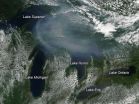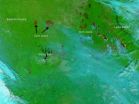(Press-News.org) Glaucoma is one of the leading causes of blindness worldwide. A major risk factor for glaucoma is elevated eye pressure due to poor drainage of aqueous humor, the fluid that provides nutrients to the eye. A specialized structure, called Schlemm's canal funnels aqueous humor from the eye back into circulation. Schlemm's canal function is critical to prevent pressure build up in the eye. In this issue of the Journal of Clinical Investigation, two research groups reveal that Schlemm's canal shares features of lymphatic vessels, which maintain interstitial fluid homeostasis. These results challenge the current view that they eye lacks lymphatic structures. Gou Young Koh and colleagues at Korea Advanced Institute of Science and Technology reveal that the presence of a lymphatic marker (PROX1) is indicative of proper of Schlemm's canal function and is absent under pathological conditions. Kari Alitalo and colleagues at the University of Helsinki show that a lymphatic growth factor (VEGF-C) reduces eye pressure and improves drainage through Schlemm's canal. In the companion commentary, Natalie Karpinich and Kathleen Caron indicate that the results from these studies many improve both therapeutics and diagnostics for glaucoma.
INFORMATION:
TITLE:
The Schlemm's canal is a VEGF-C/VEGFR-3 responsive lymphatic-like vessel
AUTHOR CONTACT:
Kari Alitalo
Biomedicum Helsinki; University of Helsinki, Helsinki, FIN
Phone: +358 9 191 25511; Fax: +358 9 191 25510; E-mail: kari.alitalo@helsinki.fi
View this article at:
http://www.jci.org/articles/view/75395?key=6b95849c28b310716341
ACCOMPANYING ARTICLE
TITLE:
Lymphatic regulator PROX1 determines Schlemm's canal integrity and identity
AUTHOR CONTACT:
Gou Young Koh
Korea Advanced Institute of Science and Technology, Daejeon, , KOR
Phone: 82-42-350-2638; E-mail: gykoh@kaist.ac.kr
ACCOMPANYING COMMENTARY
TITLE:
Schlemm's canal: more than meets the eye, lymphatics in disguise
AUTHOR CONTACT:
Kathleen M. Caron
The Univ. of North Carolina-Chapel Hill, Chapel Hill, NC, USA
Phone: (919) 966-5215; Fax: (919) 966-5230; E-mail: kathleen_caron@med.unc.edu
View this article at:
http://www.jci.org/articles/view/77507?key=e8b670be6c6be16f0505
Researchers uncover the secret lymphatic identity of the Schlemm's canal
2014-07-26
ELSE PRESS RELEASES FROM THIS DATE:
First national study finds trees saving lives, reducing respiratory problems
2014-07-25
SYRACUSE, N.Y., July 25, 2014– In the first broad-scale estimate of air pollution removal by trees nationwide, U.S. Forest Service scientists and collaborators calculated that trees are saving more than 850 human lives a year and preventing 670,000 incidences of acute respiratory symptoms.
While trees' pollution removal equated to an average air quality improvement of less than 1 percent, the impacts of that improvement are substantial. Researchers valued the human health effects of the reduced air pollution at nearly $7 billion every year in a study published recently ...
Fire ecology manipulation by California native cultures
2014-07-25
Before the colonial era, 100,000s of people lived on the land now called California, and many of their cultures manipulated fire to control the availability of plants they used for food, fuel, tools, and ritual. Contemporary tribes continue to use fire to maintain desired habitat and natural resources.
Frank Lake, an ecologist with the U.S. Forest Service's Pacific Southwest Station, will lead a field trip to the Stone Lake National Wildfire Refuge during the Ecological Society of America's 99th Annual Meeting, in Sacramento, Cal. this August. Visitors will learn about ...
Smoke from Canadian fires hover over Great Lakes
2014-07-25
Canadian wildfires have been raging this summer and some of the smoke from those fires is drifting downward into the U.S. In this image collected by the Moderate Resolution Imaging Spectroradiometer (MODIS) aboard the Aqua satellite on July 24, 2014 a swath of smoke has descended over the Great Lakes region of the United States. What is particularly interesting is the fire image from July 23, 2014 (first image feature highlighted below) clearly shows the path of the smoke as it drifts off southeastward. In the image, it is over Manitoba and parts of Ontario, and by ...
Slow walking speed and memory complaints can predict dementia
2014-07-25
July 25, 2014—(BRONX, NY)—A study involving nearly 27,000 older adults on five continents found that nearly 1 in 10 met criteria for pre-dementia based on a simple test that measures how fast people walk and whether they have cognitive complaints. People who tested positive for pre-dementia were twice as likely as others to develop dementia within 12 years. The study, led by scientists at Albert Einstein College of Medicine of Yeshiva University and Montefiore Medical Center, was published online on July 16, 2014 in Neurology®, the medical journal of the American Academy ...
Scalping can raise ticket prices
2014-07-25
Scalping gets a bad rap. For years, artists and concert promoters have stigmatized ticket resale as a practice that unfairly hurts their own sales and forces fans to pay exorbitant prices for tickets to sold-out concerts. But is that always true?
A new study by Victor Bennett, assistant professor of management and organization at the USC Marshall School of Business, along with colleagues at New York University and the Harvard Business School, finds that resale markets like Craigslist can add value to tickets sold by concert venues and Ticketmaster. "Cannibalization and ...
Burn scars in Eastern Russia
2014-07-25
The burn scars on this false-color image from the Terra satellite show the different areas that have been affected by this year's rash of wildfires in Eastern Russia. The burn scars show up as reddish-brown splotches of color against the green background. The wildfires have broken across the remote parts of Eastern Russia in the Sakha Republic. Even in this false-color image from the MODIS instrument, it is still possible to see the smoke rising from the fires that continue. Two recent image features noted below show the devastating number of fires that have plagued ...
Anti-inflammatory drug can prevent neuron loss in Parkinson's model
2014-07-25
An experimental anti-inflammatory drug can protect vulnerable neurons and reduce motor deficits in a rat model of Parkinson's disease, researchers at Emory University School of Medicine have shown.
The results were published in the Journal of Parkinson's Disease.
The findings demonstrate that the drug, called XPro1595, can reach the brain at sufficient levels and have beneficial effects when administered by subcutaneous injection, like an insulin shot. Previous studies of XPro1595 in animals tested more invasive modes of delivery, such as direct injection into the brain.
"This ...
New EMS system in Arizona dramatically improves survival from cardiac arrest
2014-07-25
WASHINGTON -- A new system that sent patients to designated cardiac receiving centers dramatically increased the survival rate of victims of sudden cardiac arrest in Arizona, according to a study published online yesterday in Annals of Emergency Medicine.
"We knew lives would be saved if the hospitals implemented the latest cutting edge guidelines for post-cardiac arrest care and we were able to get cardiac arrest patients to those hospitals, similar to what is done for Level 1 trauma patients," said lead study author Daniel Spaite, MD, Director of EMS Research at the ...
Tropical Storm Genevieve forms in Eastern Pacific
2014-07-25
The seventh tropical depression of the Eastern Pacific Ocean formed and quickly ramped up to a tropical storm named "Genevieve." NOAA's GOES-West satellite captured an infrared image of the newborn storm being trailed by two other areas of developing low pressure to its east.
The National Hurricane Center (NHC) noted that Tropical Storm Genevieve was born on July 25 at 5 a.m. EDT. At that time, Genevieve had maximum sustained winds near 40 mph (65 kph). It was located near 12.2 north latitude and 134.4 west longitude, about 1,490 miles (2,400 km) east-southeast of South ...
Climate change increases risk of crop slowdown in next 20 years
2014-07-25
BOULDER -- The world faces a small but substantially increased risk over the next two decades of a major slowdown in the growth of global crop yields because of climate change, new research finds.
The authors, from Stanford University and the National Center for Atmospheric Research (NCAR), say the odds of a major production slowdown of wheat and corn even with a warming climate are not very high. But the risk is about 20 times more significant than it would be without global warming, and it may require planning by organizations that are affected by international food ...



